
Classic Buses Profiles
Southdown open-top Guy Arabs (by Dick Gilbert)
Last updated 9 May 2024

SOME LINKS WITHIN THIS WEBSITE:
Home
Email
Links
THE COMPLETE WEBSITE MENU
Events Diary
Halfcab list
Small-Ads
Classic Irish Buses
Classic Manx Buses
Another look at some delightful vehicles from the past. On this page we remember the 1940s
Southdown Guy Arabs, and those that were later converted to open-top.
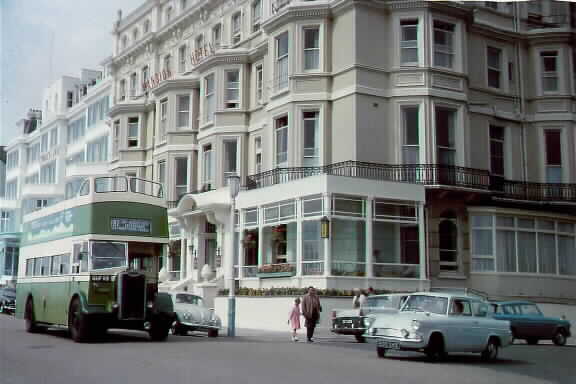
For those that remember the south coast of England in the 1950s and 60s, this atmospheric picture
conjures up memories of ice cream and sand castles. Southdown Guy Arab no. 419 (GUF 119) wanders back down Eastbourne sea front
after a trip on route 197 to Beachy Head and Birling Gap. The facades of typical Eastbourne hotels look out over the sea, with
the bandstand to the left of this picture and the pier behind the camera. 419 will work its way eastwards along Grand Parade to
Royal Parade, where the service terminates, and a 1920s Southdown garage (closed in 1972) is its home.
Roger Hardy took this picture in (probably) 1962. My thanks to him for letting me use it.
INTRODUCTION
In 1943, Southdown Motor Services started taking delivery of a batch of utility Guy Arabs, that
eventually totalled 100. It took three years to deliver them all, and four different body manufacturers were involved, Northern
Counties, East Lancs, Weymann and Park Royal.
Most had 54-seat highbridge bodies, and they could be found all over the Southdown area of
operation. In an attempt to avoid confusion between those that would go under low bridges and those that wouldn't, highbridge
buses were given an H suffix after the fleet number, and lowbridge examles were suffixed L. Later, 33 had conversions to open-top
configuration (32 for passenger work, and one as a tree-lopper), and many of these then served until the 1960s. They were used
mainly for seafront services along the Sussex coast, but also sometimes ventured inland to areas such as the spectacular Devil's
Dyke, north of Brighton.
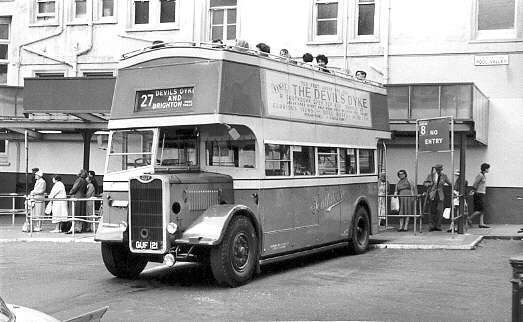
No. 421 prepares to depart Brighton's Pool Valley on route 27 to Devil's Dyke on 29 July 1961.
Photo by kind permission of Nigel Lemon.
Although withdrawals commenced in the late 1950s (and a large number could be seen in Light's
scrapyard in Greystone Quarry, just outside Lewes, in 1962) seventeen of these conversions survived until they were replaced by
Leyland PD3/4s in 1964. I was informed by Paul Statham of Portsmouth that one survived, in Denmark, but we weren't sure which one.
Now, thanks to Adrian Clarke, we know that it is no. 451, and I can add the excellent news that it has returned to the U. K. for
restoration in its home county of Sussex.
ROUTES
Through the 1950s and early 1960s Southdown operated seven sightseeing routes which regularly used
the open-top Guy Arabs. They were as follows:
Route 27: Operated from Brighton (Pool Valley) to Devil's Dyke
Route 31: Operated from Brighton (Pool Valley) to Devil's Dyke (hourly in summer)
Route 97: Operated from Eastbourne (Royal Parade) to the Top of Beachy Head
Route 102: Operated from Arundel to Devil's Dyke, via Goring, Worthing, Shoreham, Brighton
and Patcham. This was reputed to be the UK's longest open-top route - 34 miles.
Route 102A: Operated from Shoreham (Greenways Crescent) to Goring via Worthing.
Route 149: Operated on Hayling Island; Eastoke Sandy Point, Beachlands, Eastney Ferry.
Route 197: Operated from Eastbourne (Royal Parade) to Beachy Head and Birling Gap.
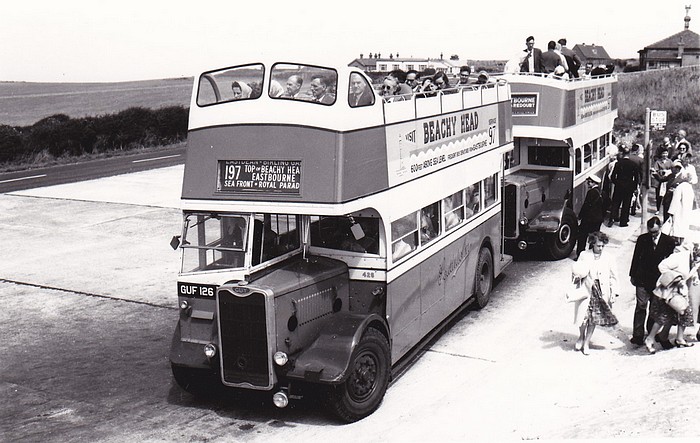
Guy Arabs 426 (GUF 126) and 467 (GUF 167) loaded with happy trippers at the top of Beachy Head in
the early 1960s. Photographer not known.
The Southdown service to the top of Beachy Head had been part of a long-standing agreement between
them and Eastbourne Corporation which kept the Corporation buses strictly within the town limits. This gave Southdown the right
to operate a service (route 97) from their Royal Parade garage (closed in 1972) on the seafront near Princes Park, which wound up
the steep hairpins to the top of Beachy Head or, in the case of route 197, onward to Birling Gap, returning via East Dean and
through the town centre.
The history of this route dates back to the first world war, during which local coach operator,
Chapman and Sons, started regular sightseeing trips to the top of Beachy Head using a variety of antiquated vehicles. During the
1920s Dennis charabancs were used, and the charter of one of their vehicles (seating 15 or more) for a trip from their town
office to Beachy Head and Birling Gap in 1930 was three shillings and sixpence.
In the mid 1920s Southdown began to establish itself in the town, and was operating similar
charabanc tours all over Sussex. Scheduled Southdown bus services also commenced in 1929. As a result of the Road Traffic Act in
1930 Southdown found itself in a strong position to bid for additional licences, and Chapmans were furious to learn that their
traditional rights to operate to Beachy Head had been awarded to Southdown. Seeing little future against such heavy opposition,
Chapmans then sold out to Southdown, who acquired their fleet, spares and properties.
A protracted argument then broke out between Southdown and Eastbourne Corporation who appealed
against the licence award to operate to the top of Beachy Head and, for a while, the two organisations operated alternately for
two week periods each. The Corporation were, at the time, charging a fare of 8 pence from the Pier to Beachy Head. The heated
dispute was finally resolved by the commissioners on the understanding that only single-deckers were permitted to be used by
Southdown.
In order to accommodate a greater number of passengers on the then-new route 97 without
contravening the single-deck limitation, Southdown in 1934 acquired two glamorous six-wheel Leyland Tiger TS6T 40-seaters with
folding roofs, followed by two similar TS7T models in 1935. Due to the additional chassis length permitted for 3-axle buses,
Southdown were able to carry more people yet stay within the law.
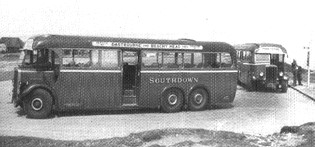
These machines can only be described as fabulous! They had very stylish Short Bros. bodywork with a
centre entrance, and were converted from petrol to diesel in 1940. Here is a quick glimpse of two of them at the top of Beachy
Head on route 97 (photo copyright unknown). In the foreground is no. 552, one of the two TS7T models of 1935, with no. 551, a
TS6T delivered in 1934, on the right. I feel they were the most attractive vehicles ever operated by Southdown, and it's such a
shame that none of them survived.
The services were restarted in 1945 after wartime curtailment and the boost in post-war holiday
traffic soon meant that the service 97 was operating hourly throughout the year, and every 15 minutes during summer peaks. Route
197 ran every 30 minutes. The 6-wheel Tigers had to be supplemented with more conventional 4-wheel models to keep up the pace. In
1952 the restriction on the use of double-deckers was lifted and open top conversions of utility Guy Arabs began to appear. This
made sense for Southdown, but unfortunately resulted in the retirement of the glorious six-wheeled single deckers.
Due to the extremely steep route and hairpins up to the top of Beachy Head, it was found necessary
to fit all Eastbourne-based Arabs with the more powerful Gardner 6LW engine. Even in 1960, the service was still operating
throughout the year, and every 30 minutes in the summer, but the appeal was declining. In 1964 the last of the Guy Arabs were
retired and replaced by new Leyland PD3/4 Queen Marys with removable roofs. These distinctive Southdown buses acquired numbers in
the 400 series of the buses they were replacing, and they continued to operate the route through the 1970s until, in 1983,
Eastbourne Buses finally started regular services to the top of Beachy Head.
These days the old 97 service is run by Eastbourne Buses only. Now numbered route 3, it traverses
an even longer route, starting at the Sovereign Centre in what is now a thriving area, but had previously been a vast, unused
shingle wasteland beyond Princes Park. From there it runs along the front, past the Pier and Holywell, and then up to the top of
Beachy Head. The old Southdown Royal Parade Garage has been demolished and replaced by a block of flats.
Much swapping of bodies took place during the lives of these vehicles, and the details are listed
below when known. Several buses were upgraded from the Gardner 5LW to the more powerful 6LW engine on conversion to open-top,
a necessity on such as the Beachy Head and Devils Dyke routes due to the steep hills.
The fleet lists below examine first the entire batch as delivered, and then take a closer look at
those that were converted.
Particular thanks go to Adrian Clarke for providing a vast quantity of information, which has been
a great help in getting the facts straight.
As with my other lists, mistakes are bound to creep in, and some relevant information may be
missing so, in order to make it as accurate a reference as possible, I would of course welcome any additions or corrections.
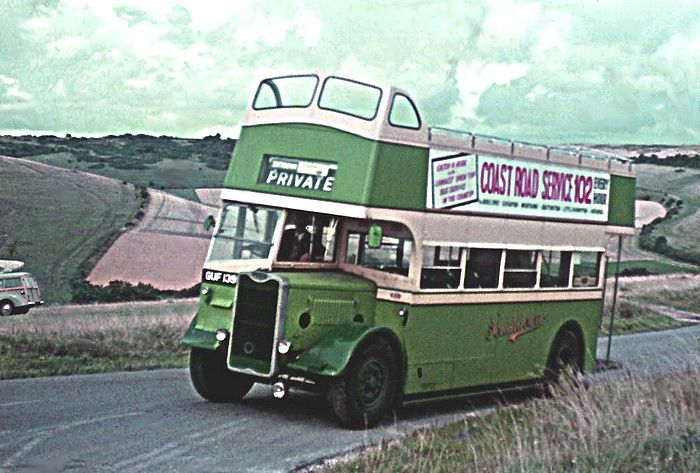
No. 439 climbing Devil's Dyke on 1 September 1963. Photo by kind permission of Cliff Essex
FLEET LIST (as delivered)
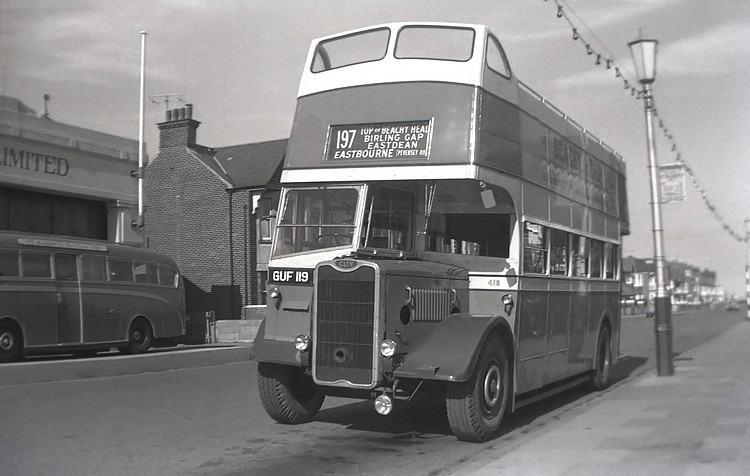
No. 419 opposite Royal Parade garage (closed 1972), Eastbourne in 1962. (photo Dick Gilbert)

No. 491 was one of thirteen examples sold in 1955/56 to the Llandudno and Colywn Bay Electric Railway, in
North Wales, the last being withdrawn in 1961. The others were 428, 433, 455, 459, 465, 475, 477, 483, 487, 488, 493 and 498.
GUY ARAB - 400 - 499 (Total 100)
Built 1943 - 1946 (Last ones delivered March 1946)
Chassis: Guy Arab II Utility (except 400 and 401, which were Arab I). Three quarters of them had
Gardner 5LW engines, the remainder had Gardner 6LW engines. Chassis numbers are marked Ch:.
Bodies: Various utility - see below for details. Seven delivered in 1944 had lowbridge bodies with
side gangways in the upper deck. Some early vehicles also had East Lancs highbridge bodies taken from pre-war Leyland Titan TDs.
- 400L (GCD 974) Arab I, 5LW. Ch: FD25940, deliv.5/43. Northern Counties (b/n 3438) UL27/28R, 10/49 reseated L26/26R, 6/51 rebodied East Lancs H28/26R from 958 (UF9758), old body to J. Light (breaker) Lewes and scrapped. Based Littlehampton early 1950s (nicknamed boneshaker), based Worthing 1954-60. Sold 6/63 to F. Cowley (dealer), Salford. To Ashley and Sons, Mansfield Woodhouse, Notts 12/63.
- 401L (GCD 975) Arab I, 5LW. Ch: FD25941, deliv.5/43. Northern Counties (b/n 3439) UL27/28R, 10/49 reseated L26/26R, 7/51 rebodied East Lancs H28/26R from pre-war Leyland 956 (UF 9756), old body to J. Light (breaker) Lewes and scrapped. Based Worthing 1954. Sold 6/63 to to F. Cowley (dealer), Salford, then to Hoyle and Sons (breaker), Wombwell, Yorks and scrapped.
- 402L (GCD 976) Arab II, 5LW. Ch: FD26187, deliv.10/43. Strachan UL27/28R, 9/49 reseated L26/28R, 6/51 rebodied East Lancs H28/26R from 950 (UF 8850), old body to J. Light (breaker), Lewes and scrapped. Based Worthing 1954. Sold 10/59 to F. Cowley (dealer), Salford, then to John Finlan (contractor), Warrington, Lancs.
- 403L (GCD 689) Arab II, 5LW. Ch: FD26243, deliv.11/43. Strachan UL27/28R, 9/49 reseated L26/28R, 5/51 rebodied East Lancs H28/26R from 954 (UF 8854), old body to J. Light (breaker), Lewes and scrapped. Based Worthing 1954. Sold 4/58 to F. Cowley (dealer), Salford. To Nottingham Sports Ltd, Bulwell 5/59. Last licence expired 31/12/59.
- 404L (GCD 690) Arab II, 5LW. Ch: FD26244, deliv. 12/43. Strachan UL27/28R, 10/49 reseated L26/28R, 8/51 rebodied East Lancs H28/26R from 940 (UF8380), old body to J. Light (breaker), Lewes and scrapped. Based Worthing 1954. Sold 5/59 to F. Cowley (dealer), Salford. To Sir Robert Lloyd (contractor), Bromborough, Cheshire 6/59. Returned to F. Cowley 10/62. Scrapped by 11/63.
- 405H (GCD 691) Arab II, 6LW. Ch: FD26632, deliv.5/44. Strachan UH30/26R, 9/51 rebodied East Lancs H28/26R from 959 (UF 9759) and Re-engined 5LW. Old body to J. Light (breaker), Lewes and scrapped. Based Worthing 1954-60. Sold 5/63 to F. Cowley (dealer), Salford.
- 406H (GCD 692) Arab II, 6LW. Ch: FD26639, deliv.5/44. Strachan UH30/26R, 8/51 rebodied East Lancs H28/26R from 952 (UF 8852), old body to J. Light (breaker), Lewes and scrapped. Re-engined 5LW 5/59. Based Worthing 1954-60. Sold 5/63 to F. Cowley (dealer), Salford.
- 407H (GUF 37) Arab II, 6LW. Ch: FD26857, deliv.6/44. Strachan UH30/26R, 9/51 rebodied East Lancs {2872} H28/26R from Leyland TD1 955 (UF 9755) and Re-engined 5LW. Old body to J. Light (breaker), Lewes and scrapped. Based Worthing 1954. Sold 7/59 to F. Cowley (dealer), Salford. From 9/59 to 11/61 with F. Goldsmith, Sicklesmere, Suffolk. To Bone (breaker) Highwood, Chelmsford, Essex 1/64 and scrapped.
- 408H (GUF 68) Arab II, 6LW. Ch: FD26648, deliv.3/44. Park Royal (b/n 25247) UH30/26R, 4/52 converted to O30/26R, (then see below).
- 409H (GUF 69) Arab II, 6LW. Ch: FD26649, deliv.3/44 to Brighton, all-over grey. Park Royal (b/n 25248) UH30/26R, 7/50 re-engined 5LW, 7/50 the first to be converted to O30/26R (then see below). Withdrawn Mar 1959.
- 410H (GUF 70) Arab II, 5LW. Ch: FD26762, deliv.4/44. Park Royal (b/n 25281) UH30/26R, 1/51 converted to O30/26R (then see below). Withdrawn Apr 1959.
- 411H (GUF 71) Arab II, 5LW. Ch: FD26820, deliv.5/44. Park Royal (b/n 28517) UH30/26R, 2/51 converted to O30/26R (then see below). Withdrawn Jun 1959.
- 412H (GUF 72) Arab II, 5LW. Ch: FD26821, deliv.5/44. Park Royal (b/n 28518) UH30/26R, 2/51 converted to O30/26R (using body tranferred from No.485 (GUF 185) and re-engined 6LW (then see below). Withdrawn June 1964.
- 413H (GUF 73) Arab II, 5LW. Ch: FD26823, deliv.6/44. Park Royal (b/n 28519) UH30/26R, 2/51 converted to O30/26R and re-engined 6LW (then see below). Withdrawn May 1959.
- 414L (GUF 74) Arab II, 5LW. Ch: FD27264, deliv.12/44. Weymann (b/n C8257) UL27/28R. Body removed 4/55 and sold to J. Light (breaker), Lewes. Based Portsmouth 1954. Chassis broken up by Southdown, Portslade 12/55.
- 415L (GUF 75) Arab II, 5LW. Ch: FD27265, deliv.12/44. Weymann (b/n C8273) UL27/28R. Based Portsmouth 1954. Body removed 4/55, sold to J. Light (breaker), Lewes and scrapped. Chassis broken up by Southdown, Portslade 12/55.
- 416H (GUF 116) Arab II, 6LW. Ch: FD26971, deliv.8/44 to Brighton, all-over grey. Northern Counties (b/n 3637) UH30/26R, 4/52 rebuilt to H28/26R. Based Brighton 1954. Re-engined 5LW 2/58 and sold to F. Cowley (dealer), Salford. To Trimdon Motor Services, Co. Durham 4/58 as no. 23. Returned to F. Cowley 6/59.
- 417H (GUF 117) Arab II, 6LW. Ch: FD26976, deliv.8/44. Northern Counties (b/n 3643) UH30/26R, 1/52 re-engined 5LW and rebuilt to H28/26R. Based Brighton 1954, Worthing 1960-63. Sold 5/63 to F. Cowley (dealer) Salford, and to C. Hoyle (breaker), Wombwell, Yorks and scrapped.
- 418H (GUF 118) Arab II, 6LW. Ch: FD27123, deliv.10/44. Northern Counties (b/n 3672) UH30/26R, 9/52 re-engined 5LW and rebuilt to H28/26R. Based Eastbourne 1954, Worthing 1960, withdrawn 5/63 and sold to F. Cowley (dealer) Salford. To Silcox Motor Coach, Pembroke Dock, no. 16, 7/63. Withdrawn by 8/68.
- 419H (GUF 119) Arab II, 6LW. Ch: FD27120, deliv.10/44. Northern Counties (b/n 3671) UH30/26R, 3/52 re-engined 5LW, 2/54 rebuilt to H28/26R, 2/57 re-engined 6LW, 4/59 converted to open-top O30/26R (see below). Sold 4/64 to C. Tennant (contractor), Stockton-on-Tees. Last licence with Tennant expired 3/66, then to Kaye Dwellings Club (caravan), Billingham, Co.Durham.
- 420H (GUF 120) Arab II, 6LW. Ch: FD27121, deliv.10/44. Northern Counties (b/n 3674) UH30/26R. Painted wartime grey, based Brighton. Decorated 1948 for a road safety week, Brighton. 9/49 rebuilt to H28/26R, 3/57 converted to open-top O30/26R (see below). Sold 6/64 to F. Cowley (dealer) Salford.
- 421H (GUF 121) Arab II, 6LW. Ch: FD27119, deliv.10/44. Northern Counties (b/n 3673) UH30/26R, 8/49 rebuilt to H28/26R. 4/57 converted to open-top O30/26R (see below). Sold 6/64 to F. Cowley (dealer) Salford.
- 422H (GUF 122) Arab II, 6LW. Ch: FD27247, deliv.11/44. Northern Counties (b/n 3707) UH30/26R, 8/49 rebuilt to H28/26R. 9/57 re-engined 5LW and withdrawn. Sold to F. Cowley (dealer) Salford 9/57. To A. R. Symond, South Kirkby, Yorks 9/57. To T.Farmery, South Elmsall, Yorks 10/58. To W. North (dealer) Leeds 4/59.
- 423H (GUF 123) Arab II, 6LW. Ch: FD27248, deliv.11/44. Northern Counties (b/n 3708) UH30/26R, 2/53 rebuilt to H28/26R. 4/59 converted to open-top O30/26R (see below). Sold 6/64 to F. Cowley (dealer) Salford.
- 424H (GUF 124) Arab II, 6LW. Ch: FD27325, built 1/45. Northern Counties (b/n 3724) UH30/26R, 3/50 rebuilt to H28/26R. 2/57 converted to open-top O30/26R (see below)
- 425H (GUF 125) Arab II, 6LW. Ch: FD27326, built 1/45. Northern Counties (b/n 3725) UH30/26R, 10/50 rebuilt to H28/26R. 2/58 re-engined 5LW and sold to Trimdon Motor Services.
- 426H (GUF 126) Arab II, 6LW. Ch: FD27327, built 1/45. Northern Counties (b/n 3723) UH30/26R, 7/53 rebuilt to H28/26R. 4/59 converted to open-top O30/26R (see below)
- 427H (GUF 127) Arab II, 5LW. Ch: FD27004, deliv.8/44 to Brighton, all-over grey. Northern Counties (b/n 3642) UH30/26R, 1/53 rebuilt to H28/26R. Based Portsmouth 1954. Sold 12/57 to F. Cowley (dealer), Salford. To Trimdon Motor Services, Co.Durham (No.18) 2/58. Sold 9/59 to dealer and scrapped.
- 428H (GUF 128) Arab II, 5LW. Ch: FD27005, deliv.8/44. Northern Counties (b/n 3644) UH30/26R, 12/51 rebuilt to H28/26R. Based Worthing 1954. Sold 11/55 to Llandudno and Colwyn Bay Electric Railway (no. 3). Withdrawn 8/57 and broken up for spares at Rhos-on-Sea 1/58.
- 429H (GUF 129) Arab II, 5LW. Ch: FD27006, deliv.8/44. Northern Counties (b/n 3645) UH30/26R, 1/54 rebuilt to H28/26R. Based Portsmouth 1954. Sold 5/63 to F. Cowley (dealer) Salford. To R. J. Bleanch, Hetton-le-Hole, Co. Durham 10/63. Withdrawn 1/65 and scrapped.
- 430H (GUF 130) Arab II, 5LW. Ch: FD27017, deliv.8/44. Northern Counties (b/n 3649) UH30/26R, 10/54 rebuilt to H28/26R. Based Portsmouth 1954. Sold 5/63 to F. Cowley (dealer) Salford. To Premier Travel, Cambridge (no. 106) 6/57. To F. Cowley (dealer) Salford 3/62. To Wogan (breaker) Barnsley 7/62 and scrapped.
- 431H (GUF 131) Arab II, 5LW. Ch: FD27092, deliv.9/44. Northern Counties (b/n 3663) UH30/26R, 2/52 rebuilt to H28/26R. Based Worthing 1954. Sold 3/57 to F. Cowley (dealer) Salford. To Premier Travel, Cambridge (no. 104) 3/57. To F. Cowley (dealer) Salford 2/62. To Cubbins (dealer) Farnworth, Bolton 4/62.
- 432H (GUF 132) Arab II, 5LW. Ch: FD27091, deliv.9/44. Northern Counties (b/n 3662) UH30/26R, 5/53 rebuilt to H28/26R. Based Worthing 1954-60. Sold 6/63 to F. Cowley (dealer) Salford. To S. Hoyle and Sons (breaker), Wombwell, Yorks 1963.
- 433H (GUF 133) Arab II, 5LW. Ch: FD27093, deliv.9/44. Northern Counties (b/n 3661) UH30/26R, 8/50 rebuilt to H28/26R and re-engined 6LW. Based Worthing 1954. 11/55 re-engined 5LW, withdrawn and sold to Llandudno and Colwyn Bay Electric Railway (no. 4), withdrawn 12/58. 1959/60 work started to open top conversion, but not completed. 5/61 to Colbro (dealer) Rothwell, Yorks.
- 434H (GUF 134) Arab II, 5LW. Ch: FD27094, deliv.9/44. Northern Counties (b/n 3664) UH30/26R. Based Portsmouth 1954. Withdrawn 3/56 and sold to Faulkner (contractor) Waterlooville, Hants. Scrapped by 1960.
- 435H (GUF 135) Arab II, 5LW. Ch: FD27095, deliv.9/44. Northern Counties (b/n 3665) UH30/26R, 10/54 rebuilt to H28/26R. Based Portsmouth 1954. Sold 5/63 to F. Cowley (dealer), Salford. 7/63 to Silcox, Pembroke Dock (no. 14). 12/67 to Hartwood Finance (dealer), Barnsley. Scrapped 1968.
- 436H (GUF 136) Arab II, 5LW. Ch: FD27165, deliv.10/44. Northern Counties (b/n 3684) UH30/26R, 11/51 rebuilt to H28/26R. Based Worthing 1954. Sold 1/57 to F. Cowley (dealer) Salford. To Premier Travel (no. 102), Cambridge 3/57. Returned to F. Cowley 1/62. With showman at Salford 5/62.
- 437H (GUF 137) Arab II, 5LW. Ch: FD27168, deliv.10/44. Northern Counties (b/n 3685) UH30/26R, 6/54 rebuilt to H28/26R. 2/57 re-engined 6LW. 5/59 rebuilt to open-top O30/26R (see below).
- 438H (GUF 138) Arab II, 5LW. Ch: FD27145, deliv.10/44. Northern Counties (b/n 3686) UH30/26R, 10/53 rebuilt to H28/26R. Based Portsmouth 1954. Sold 5/63 to F. Cowley (dealer) Salford. 8/64 to Cubbins (dealer), Farnworth, Lancs and scrapped.
- 439H (GUF 139) Arab II, 5LW. Ch: FD27200, deliv.10/44. Northern Counties (b/n 3690) UH30/26R, 6/54 rebuilt to H28/26R. Based Portsmouth 1954. 4/59 converted to open-top O30/26R (see below)
- 440H (GUF 140) Arab II, 5LW. Ch: FD27201, deliv.10/44. Northern Counties (b/n 3691) UH30/26R, 12/53 rebuilt to H28/26R. Based Worthing 1954. 5/59 converted to open-top O30/26R (see below)
- 441H (GUF 141) Arab II, 5LW. Ch: FD27202, deliv.10/44. Northern Counties (b/n 3692) UH30/26R. Based Portsmouth 1954. 3/56 used as staff bus at Portslade works. 9/56 sold to F. Cowley (dealer) Salford. 10/56 to Clough and Gaskell (contractor) Wigan. 6/60 returned to F. Cowley. Scrapped by 6/61.
- 442H (GUF 142) Arab II, 6LW. Ch: FD27031, deliv.8/44 to Brighton, all-over grey. Park Royal UH30/26R b/n B28585. 2/51 re-engined 5LW, 3/51 converted to open-top O30/26R (see below).
- 443H (GUF 143) Arab II, 6LW. Ch: FD27034, deliv.8/44. Park Royal UH30/26R b/n B28586, 2/51 re-engined 5LW and converted to open-top O30/26R (see below).
- 444H (GUF 144) Arab II, 5LW. Ch: FD27288, deliv.12/44. Park Royal UH30/26R b/n B28604, 12/50 converted to open-top O30/26R (see below).
- 445H (GUF 145) Arab II, 5LW. Ch: FD27289, deliv.12/44. Park Royal UH30/26R b/n B28605, 12/50 converted to open-top O30/26R (see below).
- 446H (GUF 146) Arab II, 5LW. Ch: FD27432, built 3/45. Park Royal UH30/26R b/n B28606, 11/50 re-engined 5LW, 1/51 converted to open-top O30/26R (see below)
- 447H (GUF 147) Arab II, 5LW. Ch: FD27438, built 3/45. Park Royal UH30/26R b/n B28607, 2/50 re-engined 5LW, 11/50 converted to open-top O30/26R (see below).
- 448H (GUF 188) Arab II, 5LW. Ch: FD27371, built 1/45. Northern Counties (b/n 3735) UH30/26R, 2/52 rebuilt to H28/26R, based Worthing 1954. Withdrawn Jun 1957. To Trimdon Motor Services as no. 15. Withdrawn late 1958 or early 1959.
- 449H (GUF 189) Arab II, 5LW. Ch: FD27374, built 2/45. Northern Counties (b/n 3738) UH30/26R, 10/50 rebuilt to H28/26R, 11/50 re-engined 6LW, based Worthing 1954. 1/57 re-engined 5LW and withdrawn.
- 450H (GUF 190) Arab II, 5LW. Ch: FD27375, built 1/45. Northern Counties (b/n 3733) UH30/26R, 12/51 rebuilt to H28/26R, based Worthing 1954, withdrawn Jan 1957.
- 451H (GUF 191) Arab II, 5LW. Ch: FD27376, built 1/45. Northern Counties (b/n 3734) UH30/26R, Based Portsmouth 1954. 10/54 rebuilt to H28/26R, 3/59 converted to open-top O30/26R (see below) ** SURVIVOR ** exported to Denmark 1964. With Maribo and District tourist company for use at the Lollands Railway, 1971. Then to Jansen, Stubbekoebing, Denmark. At Maribo in bad condition 2000, then sold to "Dansk Veteranbil Udlejning", Hilleroed, Denmark. Returned to UK 2001 (exchanged for ex-Guernseybus RT). Ian Richardson, Worthing, under restoration by Southdown 451 Group.
- 452H (GUF 152) Arab II, 5LW. Ch: FD27378, built 2/45. Northern Counties (b/n 3736) UH30/26R, 12/49 rebuilt to H28/26R and re-engined 6LW. 2/57 converted to open-top O30/26R (see below)
- 453H (GUF 153) Arab II, 5LW. Ch: FD27379, built 2/45. Northern Counties (b/n 3737) UH30/26R, 12/50 rebuilt to H28/26R and re-engined 6LW, 7/56 re-engined 5LW and withdrawn. Sold to Trimdon Motor Services, withdrawn 1959.
- 454H (GUF 154) Arab II, 5LW. Ch: FD27389, built 2/45. Northern Counties (b/n 3739) UH30/26R, 1/51 rebuilt to H28/26R and re-engined 6LW. 7/56 re-engined 5LW. Withdrawn Jan 1957.
- 455H (GUF 155) Arab II, 5LW. Ch: FD27390, built 2/45. Northern Counties (b/n 3740) UH30/26R, 3/50 rebuilt to H28/26R and re-engined 6LW. 11/55 re-engined 5LW and withdrawn. Bought by Llandudno and Colwyn Bay Electric Railway 1956, withdrawn 1957 and rebuilt as breakdown tender.
- 456H (GUF 156) Arab II, 5LW. Ch: FD27391, built 2/45. Northern Counties (b/n 3741) UH30/26R, based Portsmouth 1954, withdrawn 4/55.
- 457H (GUF 157) Arab II, 5LW. Ch: FD27412, built 2/45. Northern Counties (b/n 3743) UH30/26R, based Eastbourne 1954, withdrawn 2/57.
- 458H (GUF 158) Arab II, 5LW. Ch: FD27413, built 2/45. Northern Counties (b/n 3744) UH30/26R, 4/52 rebuilt to H28/26R. Based Worthing 1954-60, withdrawn May 1963.
- 459H (GUF 159) Arab II, 5LW. Ch: FD27414, built 2/45. Northern Counties (b/n 3745) UH30/26R, 9/50 rebuilt to H28/26R, 10/50 re-engined 6LW. Based Worthing 1954. 5/57 re-engined 5LW and withdrawn. Bought by Llandudno and Colwyn Bay Electric Railway 1957, converted to open-top 1960, withdrawn 1961.
- 460H (GUF 160) Arab II, 5LW. Ch: FD27418, built 2/45. Northern Counties (b/n 3746) UH30/26R. Based Portsmouth 1954. 9/55 rebuilt to open-top tree-lopper and re-numbered 0460, based at Bognor. Withdrawn Jun 1969 (the last to be withdrawn from service).
- 461H (GUF 161) Arab II, 5LW. Ch: FD27411, built 2/45. Northern Counties (b/n 3742) UH30/26R, based Portsmouth 1954, 10/55 rebuilt to tree-lopper and re-numbered 0461. Withdrawn Jun 1969.
- 462H (GUF 162) Arab II, 5LW. Ch: FD27420, built 2/45. Northern Counties (b/n 3747) UH30/26R, 6/53 rebuilt to H28/26R, based Portsmouth 1954, withdrawn Jun 1957. To Trimdon Motor Services as no. 16. Withdrawn late 1958 or early 1959.
- 463H (GUF 163) Arab II, 6LW. Ch: FD27660, built 8/45. Northern Counties (b/n 3805) UH30/26R, 10/49 rebuilt to H28/26R, based Eastbourne 1954, re-engined 5LW 1/57, withdrawn Jan 1957.
- 464H (GUF 164) Arab II, 6LW. Ch: FD27662, built 8/45. Northern Counties (b/n 3806) UH30/26R, 9/49 rebuilt to H28/26R, based Eastbourne 1954, converted to open-top O30/26R 4/57 (see below).
- 465H (GUF 165) Arab II, 6LW. Ch: FD27663, built 8/45. Northern Counties (b/n 3807) UH30/26R, 10/49 rebuilt to H28/26R, based Eastbourne 1954, re-engined 5LW 7/54, to 6LW 4/55, to 5LW and withdrawn Nov 1955. Bought by Llandudno and Colwyn Bay Electric Railway 1956, withdrawn 1959.
- 466H (GUF 166) Arab II, 5LW. Ch: FD27695, built 7/45. Park Royal UH30/26R b/n B30983, converted to open-top O30/26R (see below) 11/50.
- 467H (GUF 167) Arab II, 5LW. Ch: FD27959, built 11/45. Park Royal UH30/26R b/n B30984, converted to open-top O30/26R (see below) 5/51, based Worthing 1954, re-engined 6LW 7/56, withdrawn Jun 1964.
- 468H (GUF 168) Arab II, 5LW. Ch: FD27984, built 11/45. Park Royal UH30/26R b/n B30985, converted to open-top O30/26R (see below) 5/51, based Worthing 1954, re-engined 6LW 2/58, withdrawn Jun 1964.
- 469H (GUF 169) Arab II, 5LW. Ch: FD28015, built 11/45. Park Royal UH30/26R b/n B30986, 7/51 rebodied East Lancs H28/26R from Leyland TD2 No.942 (UF8382). (original body sold 9/51). Based Worthing 1954. Withdrawn Mar 1958 and sold to Simon Carves (contractor), Cheadle Heath.
- 470H (GUF 170) Arab II, 5LW. Ch: FD28016, built 11/45. Park Royal UH30/26R b/n B30987, 7/51 rebodied East Lancs H28/26R from Leyland TD2 No.947 (UF8847). (original body sold 9/51). Based Worthing 1954. Withdrawn Apr 1959 and sold to Sir Robert Lloyd, contractor.
- 471H (GUF 171) Arab II, 5LW. Ch: FD28017, built 11/45. Park Royal UH30/26R b/n B30988, converted to open-top O30/26R (see below) 10/50, based Worthing 1954, re-engined 6LW 9/57, withdrawn Mar 1964.
- 472H (GUF 172) Arab II, 5LW. Ch: FD28018, built 11/45. Park Royal UH30/26R b/n B30989, converted to open-top O30/26R (see below) 5/52, based Eastbourne 1954, on Devil's Dyke service no. 27 in 1962, withdrawn Jun 1964.
- 473H (GUF 173) Arab II, 6LW. Ch: FD27733, built 6/45. Weymann (b/n C8855) UH30/26R, based Portsmouth 1954, withdrawn Dec 1957. To Premier Travel, Cambridge 1958 as no. 109.
- 474H (GUF 174) Arab II, 6LW. Ch: FD27734, built 6/45. Weymann (b/n C8856) UH30/26R, based Portsmouth 1954, withdrawn Mar 1958, and sold to Sherwood's Paints, Manchester for staff transport.
- 475H (GUF 175) Arab II, 6LW. Ch: FD27766, built 7/45. Weymann (b/n C8857) UH30/26R, based Portsmouth 1954, withdrawn Apr 1956. Bought by Llandudno and Colwyn Bay Electric Railway 1956, not operated, used for spares.
- 476H (GUF 176) Arab II, 6LW. Ch: FD27771, built 7/45. Weymann (b/n C8858) UH30/26R, based Portsmouth 1954, withdrawn Mar 1958.
- 477H (GUF 177) Arab II, 6LW. Ch: FD27773, built 7/45. Weymann (b/n C8859) UH30/26R, based Portsmouth 1954, withdrawn Nov 1955. Bought by Llandudno and Colwyn Bay Electric Railway 1956, withdrawn 1961.
- 478H (GUF 178) Arab II, 6LW. Ch: FD27774, built 7/45. Weymann (b/n C8863) UH30/26R, based Portsmouth 1954, body removed and vehicle withdrawn Apr 1955.
- 479H (GUF 179) Arab II, 6LW. Ch: FD27813, built 7/45. Weymann (b/n C8860) UH30/26R, based Portsmouth 1954, withdrawn Feb 1955.
- 480H (GUF 180) Arab II, 6LW. Ch: FD27814, built 7/45. Weymann (b/n C8861) UH30/26R, based Portsmouth 1954, body removed and vehicle withdrawn Apr 1955.
- 481H (GUF 181) Arab II, 6LW. Ch: FD27815, built 7/45. Weymann (b/n C8862) UH30/26R, based Portsmouth 1954, withdrawn Mar 1958, and sold to Massey-Ferguson (tractor manufacturer) for use at their Trafford Park factory.
- 482H (GUF 182) Arab II, 6LW. Ch: FD27818, built 7/45. Weymann (b/n C8864) UH30/26R, based Portsmouth 1954, body removed and vehicle withdrawn Apr 1955.
- 483H (GUF 183) Arab II, 6LW. Ch: FD27819, built 7/45. Weymann (b/n C8865) UH30/26R, based Worthing 1954. Withdrawn Nov 1955. Sold to Llandudno and Colwyn Bay Electric Railway, inaugurating their open top services 25 Mar 1956. Withdrawn 1961.
- 484H (GUF 184) Arab II, 6LW. Ch: FD27820, built 8/45. Weymann (b/n C8866) UH30/26R, based Horsham 1954, withdrawn Feb 1956.
- 485H (GUF 185) Arab II, 6LW. Ch: FD27821, built 10/45. Weymann (b/n M2691) UH30/26R, based Worthing 1954, withdrawn Mar 1958. Body converted to open top and transferred to the chassis of No.412 (GUF 72).
- 486H (GUF 186) Arab II, 6LW. Ch: FD27822, built 11/45. Weymann (b/n M2692) UH30/26R, based Eastbourne 1954, withdrawn Dec 1955. With Trimdon Motor Services 1958, but withdrawn 1959.
- 487H (GUF 387) Arab II, 6LW. Ch: FD28033, built 11/45. Weymann (b/n C8899) UH30/26R, based Eastbourne 1954, withdrawn Dec 1955. Bought by Llandudno and Colwyn Bay Electric Railway 1956, withdrawn 1961.
- 488H (GUF 388) Arab II, 6LW. Ch: FD28034, built 11/45. Weymann (b/n C8906) UH30/26R, based at Portslade Works 1954, body removed and vehicle withdrawn Apr 1955. Bought by Llandudno and Colwyn Bay Electric Railway 1956, withdrawn 1961. (A conflicting report says it was with Trimdon Motor Services in 1958, but I doubt this.)
- 489H (GUF 389) Arab II, 6LW. Ch: FD28038, built 11/45. Weymann (b/n C8905) UH30/26R, based Brighton, then Portsmouth 1954. Body removed and vehicle broken up for spares Apr 1955.
- 490H (GUF 390) Arab II, 6LW. Ch: FD27982, built 11/45. Weymann (b/n C8941) UH30/26R, based Portsmouth 1954, withdrawn Jul 1959 and sold to Hayes, Clock Face.
- 491H (GUF 391) Arab II, 6LW. Ch: FD28037, built 12/45. Weymann (b/n C8904) UH30/26R, based Portsmouth 1954, withdrawn May 1956. Bought by Llandudno and Colwyn Bay Electric Railway (no. 11) 1956, withdrawn 1961.
- 492H (GUF 392) Arab II, 6LW. Ch: FD28039, built 11/45. Weymann (b/n C8907) UH30/26R, based Portsmouth 1954, withdrawn Oct 1959.
- 493H (GUF 393) Arab II, 6LW. Ch: FD28045, built 12/45. Weymann (b/n C8940) UH30/26R, based Worthing 1954, withdrawn May 1956. Bought by Llandudno and Colwyn Bay Electric Railway 1956, withdrawn 1961.
- 494H (GUF 394) Arab II, 6LW. Ch: FD28048, built 12/45. Weymann (b/n C8942) UH30/26R, based Littlehampton 1954, withdrawn Sep 1956 and sold (with six others) to Premier Travel in 1957.
- 495H (GUF 395) Arab II, 5LW. Ch: FD28160, built 3/46. Park Royal UH30/26R b/n B31717, based Horsham 1954, withdrawn Nov 1956. Sold to Meal Service Co., Brighton for staff transport. For sale again in 1959 by dealer Thurgood of Ware, Herts.
- 496H (GUF 396) Arab II, 5LW. Ch: FD28168, built 3/46. Park Royal UH30/26R b/n B31720, 3/52 converted to open-top O30/26R (see below), based Worthing 1954, re-engined 6LW 5/57, withdrawn Jun 1964.
- 497H (GUF 397) Arab II, 5LW. Ch: FD28169, built 3/46. Park Royal UH30/26R b/n B31718, 4/52 converted to open-top O30/26R (see below) and re-engined 6LW. Withdrawn Jul 1964.
- 498H (GUF 398) Arab II, 5LW. Ch: FD28170, built 3/46. Park Royal UH30/26R b/n B31719, based Worthing 1954, withdrawn Apr 1956 and sold to Llandudno and Colwyn Bay Electric Railway. Withdrawn 1961.
- 499H (GUF 399) Arab II, 5LW. Ch: FD28171, built 3/46. Park Royal UH30/26R b/n B31721, 5/52 converted to open-top O30/26R (see below), withdrawn Jun 1964.
TOTAL 100 (with 1 survivor)
FLEET LIST (converted to open top)
GUY ARAB - 408 - 499 (Total 33)
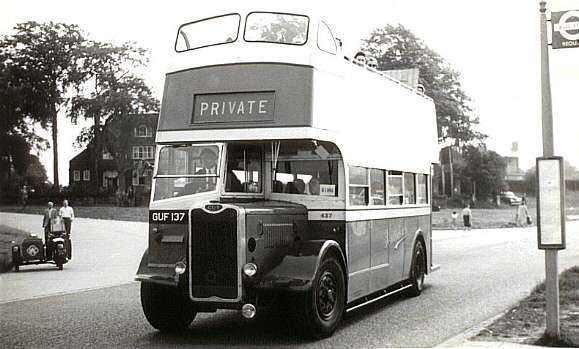
An interesting photo of no. 437 (GUF 137). It looks quite smart, so it may well be soon after its
conversion to open-top in 1959 - it was withdrawn in 1964, so only spent 5 years in this guise. The London Transport bus stop on
the right shows that it is well away from its normal operating area, and Paul Snelling tells me that the picture was taken at
Tattenham Corner, so this is almost certainly a private hire trip to the races at Epsom, probably on Derby Day. What is the
upright board at the back on the upper deck - a windbreak? The RAC motorbike on the left gives the picture a nice period touch.
(Photo: unknown)
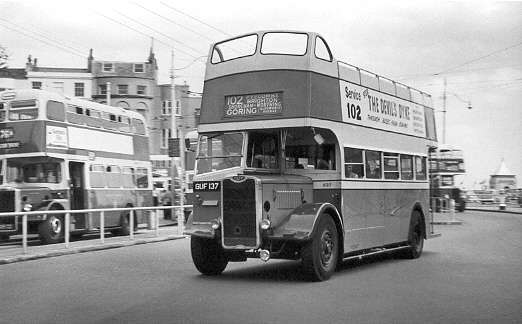
No. 437 (GUF 137) again, this time on more conventional duties as it passes Old Steine, Brighton
at the start of the lengthy route 102 on 29 July 1961. Photo by Nigel Lemon.
Built 1943 - 1946
Chassis: Guy Arab II Utility, mostly with Gardner 6LW engines.
Bodies: Various - see below. Some had windscreens on the upper deck, some didn't. Although 32 were
used for passenger service, one (460) had its roof removed for use as a tree lopper at Bognor, so it has been included in the
list. Some others were also converted to open-top for service in North Wales after sale, but are not listed in this section (see
main list above).
- 408 (GUF 68) Arab II, 6LW. Ch: FD26648, deliv.3/44. Park Royal (b/n 25247) UH30/26R, 4/52 converted to O30/26R. Based Eastbourne 1954. Engine removed 5/59 and remainder sold to J. Light (breaker), Lewes. Noted still virtually complete in Light's yard 6/60.
- 409 (GUF 69) Arab II, 6LW. Ch: FD26649, deliv.3/44. Park Royal (b/n 25248) UH30/26R, 7/50 re-engined 5LW, 7/50 the first to be converted to open-top (O30/26R). Based Portsmouth 1954. Sold to J. Light (breaker), Lewes 3/59 and scrapped.
- 410 (GUF 70) Arab II, 5LW. Ch: FD26762, deliv.4/44. Park Royal (b/n 25281) UH30/26R, 1/51 converted to O30/26R. Based Portsmouth 1954. Sold to J. Light (breaker), Lewes 4/59. Still in their yard 6/60.
- 411 (GUF 71) Arab II, 5LW. Ch: FD26820, deliv.5/44. Park Royal (b/n 28517) UH30/26R, 2/51 converted to O30/26R. Sold to J. Light (breaker), Lewes 6/59 and scrapped.
- 412 (GUF 72) Arab II, 5LW. Ch: FD26821, deliv.5/44. Park Royal (b/n 28518) UH30/26R, 2/51 converted to O30/26R (using body tranferred from No.485, GUF 185) with no windscreen and re-engined 6LW. Based at Eastbourne for routes 97/197 in 1954 and later. 6/58 rebodied Weymann {M2691 tranferred from 485, GUF 185} O30/26R 485, old body to J. Light (breaker), Lewes and scrapped. Sold 6/64 to F. Cowley (dealer), Salford, then to C. Hoyle (breaker), Wombwell, Yorks and scrapped.
- 413 (GUF 73) Arab II, 5LW. Ch: FD26823, deliv.6/44. Park Royal (b/n 28519) UH30/26R, 2/51 converted to O30/26R and re-engined 6LW. Based Eastbourne 1954. Engine removed 5/59 and remainder sold to J. Light (breaker), Lewes for scrap. Still in Light's yard 6/60.
- 419 (GUF 119) Arab II, 6LW. Ch: FD27120, deliv.10/44. Northern Counties (b/n 3671) UH30/26R, 3/52 re-engined 5LW, 2/54 rebuilt to H28/26R, 2/57 re-engined 6LW, 4/59 converted to open-top O30/26R based at Eastbourne for routes 97/197, windscreen fitted. Sold 4/64 to C.Tennant (contractor), Stockton-on-Tees. Last licence with Tennant expired 3/66, then to Kaye Dwellings Club (caravan), Billingham, Co.Durham.
- 420 (GUF 120) Arab II, 6LW. Ch: FD27121, deliv.10/44. Northern Counties (b/n 3674) UH30/26R. Painted wartime grey, based Brighton. Decorated 1948 for a road safety week, Brighton. 9/49 rebuilt to H28/26R, 3/57 converted to open-top O30/26R. Based Arundel 1950s/60s for route 102, without windscreen, withdrawn at end of 1963 season. Sold 6/64 to F. Cowley (dealer) Salford.
- 421 (GUF 121) Arab II, 6LW. Ch: FD27119, deliv.10/44. Northern Counties (b/n 3673) UH30/26R, 8/49 rebuilt to H28/26R. 4/57 converted to open-top O30/26R with no wondscreen. Based at Brighton 1961-63 for route 27 to Devil's Dyke. Sold 6/64 to F. Cowley (dealer) Salford.
- 423 (GUF 123) Arab II, 6LW. Ch: FD27248, deliv.11/44. Northern Counties (b/n 3708) UH30/26R, 2/53 rebuilt to H28/26R. 4/59 converted to open-top O30/26R. Used at Eastbourne, with windscreen. Sold 6/64 to F. Cowley (dealer) Salford.
- 424 (GUF 124) Arab II, 6LW. Ch: FD27325, built 1/45. Northern Counties UH30/26R, 3/50 rebuilt to H28/26R. 2/57 converted to open-top O30/26R. Withdrawn Jun 1964.
- 426 (GUF 126) Arab II, 6LW. Ch: FD27327, built 1/45. Northern Counties UH30/26R, 7/53 rebuilt to H28/26R. 4/59 converted to open-top O30/26R, fitted with windscreen, based in Eastbourne for route 197, withdrawn June 1964.
- 437 (GUF 137) Arab II, 5LW. Ch: FD27168, deliv.10/44. Northern Counties (b/n 3685) UH30/26R, 6/54 rebuilt to H28/26R. 2/57 re-engined 6LW. 5/59 converted to open-top O30/26R. Sold 3/64 to F. Cowley (dealer) Salford, then to C. Hoyle (breaker), Wombwell, Yorks.
- 439 (GUF 139) Arab II, 5LW. Ch: FD27200, deliv.10/44. Northern Counties (b/n 3690) UH30/26R, 6/54 rebuilt to H28/26R. 4/59 converted to open-top O30/26R with windscreen, based Brighton for route 102. Sold 3/64 to F. Cowley (dealer) Salford. Seen in Chester 3/69.
- 440 (GUF 140) Arab II, 5LW. Ch: FD27201, deliv.10/44. Northern Counties (b/n 3691) UH30/26R, 12/53 rebuilt to H28/26R. 5/59 converted to open-top O30/26R. 10/59 re-engined 6LW. Sold 3/64 to F. Cowley (dealer) Salford.
- 442 (GUF 142) Arab II, 6LW. Ch: FD27031, deliv.8/44. Park Royal UH30/26R. 2/51 re-engined 5LW. 3/51 converted to open-top O30/26R with upper deck windscreen. Based at Brighton around 1960 and used on B. H. and D. seafront service 17. 4/64 sold to F. Cowley (dealer) Salford, then to Cubbins (dealer) Farnworth, Lancs.
- 443 (GUF 143) Arab II, 6LW. Ch: FD27034, deliv.8/44. Park Royal UH30/26R, 2/51 re-engined 5LW and converted to open-top O30/26R. Based Portsmouth 1954. 3/58 re-engined 6LW. 6/59 engine removed prior to sale to J. Light (breaker), Lewes. Still in Light's yard 6/60.
- 444 (GUF 144) Arab II, 5LW. Ch: FD27288, deliv.12/44. Park Royal UH30/26R, 12/50 converted to open-top O30/26R, based Eastbourne 1954. Based Arundel late 1950s for route 102, without windscreen. 7/64 sold to F. Cowley (dealer) Salford. By 6/65 to C. Hoyle and Sons (breaker) Wombwell, Yorks and scrapped.
- 445 (GUF 145) Arab II, 5LW. Ch: FD27289, deliv.12/44. Park Royal UH30/26R, 12/50 converted to open-top O30/26R. 12/55 re-engined 6LW. Sold 3/64 to F. Cowley (dealer) Salford. To Cubbins (dealer) Farnworth, Lancs. 1964.
- 446 (GUF 146) Arab II, 5LW. Ch: FD27432, built 3/45. Park Royal UH30/26R, 11/50 re-engined 5LW, 1/51 converted to open-top O30/26R with no windscreen. Based Eastbourne 1954, later based at Brighton. Withdrawn Jul 1964.
- 447 (GUF 147) Arab II, 5LW. Ch: FD27438, built 3/45. Park Royal UH30/26R, 2/50 re-engined 5LW, 11/50 converted to open-top O30/26R, based Brighton in the 1950s. 4/57 re-engined 6LW, 6/59 re-engined 5LW and withdrawn.
- 451 (GUF 191) Arab II, 5LW. Ch: FD27376, built 1/45. Northern Counties UH30/26R, 10/54 rebuilt to H28/26R, based Portsmouth 1954. 3/59 converted to open-top O30/26R (see below) ** SURVIVOR ** exported to Denmark 1964. With Maribo and District Tourist Company for use at the Lollands Railway, 1964-71. Then to Jansen, Stubbekoebing, Denmark. At Maribo in bad condition 2000, then sold to "Dansk Veteranbil Udlejning", Hilleroed, Denmark. Returned to UK 2001 (exchanged for ex-Guernseybus RT). Ian Richardson, Worthing, under restoration by Southdown 451 Group.
- 452 (GUF 152) Arab II, 5LW. Ch: FD27378, built 2/45. Northern Counties UH30/26R, 12/49 rebuilt to H28/26R and re-engined 6LW. 2/57 converted to open-top O30/26R. Withdrawn June 1964.
- 460 (GUF 160) Arab II, 5LW. Ch: FD27418, built 2/45. Northern Counties (b/n 3746) UH30/26R. 9/55 rebuilt to open-top tree-lopper by 1961 (not for PSV use) and re-numbered 0460, based at Bognor. Withdrawn Jun 1969 (the last to be withdrawn from service).
- 464 (GUF 164) Arab II, 6LW. Ch: FD27662, built 8/45. Northern Counties UH30/26R, 9/49 rebuilt to H28/26R, converted to open-top O30/36R 4/57, based Eastbourne 1961. Withdrawn Jun 1964.
- 466 (GUF 166) Arab II, 5LW. Ch: FD27695, built 7/45. Park Royal UH30/26R, converted to open-top O30/26R 11/50 without a windscreen, re-engined 6LW 1/57, based in Brighton for route 27 and 31 in 1950s/60s, but seen working on Hayling Island around 1959. Withdrawn Jul 1964.
- 467 (GUF 167) Arab II, 5LW. Ch: FD27959, built 11/45. Park Royal UH30/26R, converted to open-top O30/26R 5/51, based Worthing 1954, re-engined 6LW 7/56, withdrawn Jun 1964.
- 468 (GUF 168) Arab II, 5LW. Ch: FD27984, built 11/45. Park Royal UH30/26R, converted to open-top O30/26R 5/51, based Worthing 1954, re-engined 6LW 2/58, withdrawn Jun 1964.
- 471 (GUF 171) Arab II, 5LW. Ch: FD28017, built 11/45. Park Royal UH30/26R, converted to open-top O30/26R 10/50, based Worthing 1954, re-engined 6LW 9/57, withdrawn Mar 1964.
- 472 (GUF 172) Arab II, 5LW. Ch: FD28018, built 11/45. Park Royal UH30/26R, converted to open-top O30/26R 5/52. Based Eastbourne 1954. On Devil's Dyke service No.27 in 1961-62, withdrawn Jun 1964.
- 496 (GUF 396) Arab II, 5LW. Ch: FD28168, built 3/46. Park Royal UH30/26R, 3/52 converted to open-top O30/26R, based Worthing 1954, re-engined 6LW 5/57, withdrawn Jun 1964.
- 497 (GUF 397) Arab II, 5LW. Ch: FD28169, built 3/46. Park Royal UH30/26R, 4/52 converted to open-top O30/26R and re-engined 6LW. Based Eastbourne 1954. Withdrawn Jul 1964.
- 499 (GUF 399) Arab II, 5LW. Ch: FD28171, built 3/46. Park Royal UH30/26R, 5/52 converted to open-top O30/26R without a windscreen. Based Eastbourne 1954, then Brighton, withdrawn Jun 1964.
TOTAL 33 ( with 1 survivor )
And here is that one survivor. This image of 451 is taken from a postcard kindly sent by Thomas
Christensen, from Copenhagen, Denmark.
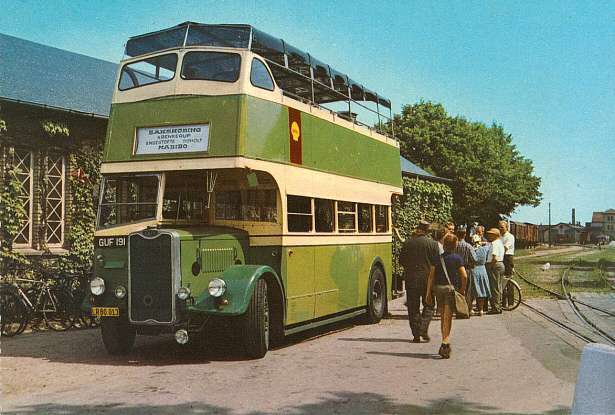
Thomas writes: The bus was servicing the Museum Triangle route between the two cities
Sakskobing and Maribo, around 1965. There still is a steam train route from the Harbour Bandholm to Maribo
(http://www.museumsbanen.dk/). In the sixties there was also a steam ferry sailing from
Sakskobing to Bandholm. Thanks very much Thomas for the picture.
So where is it now? Undergoing a complete rebuild in Worthing, West Sussex.
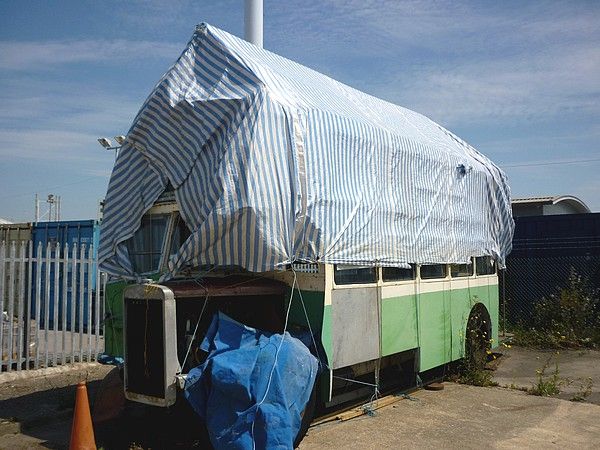
Current owner Ian Richardson very kindly invited me to visit the restoration in July 2011. It's
going to be a long hard slog to get the job done, by individuals who are still learning some of the necessary skills, and funded
by personal contributions. This is restoration in its most raw form and I wish Ian and his colleagues the very best of good
fortune in their re-creation of 191, the last surviving example of 100 charismatic buses. Photo by Dick Gilbert.
For more Southdown buses see the Southdown
Leyland Tigers - pre-war coaches, the Southdown Leyland Tigers - pre-war
buses, the Southdown Leyland Tigers - all post-war vehicles, and the
Southdown coaches 1951-1961.
For many other buses, have a look at all the other profiles on the Classic
Buses menu page.
SOME LINKS WITHIN THIS WEBSITE:
Home
Email
Links
THE COMPLETE WEBSITE MENU
Events Diary
Halfcab list
Small-Ads
Classic Irish Buses
Classic Manx Buses
SB













